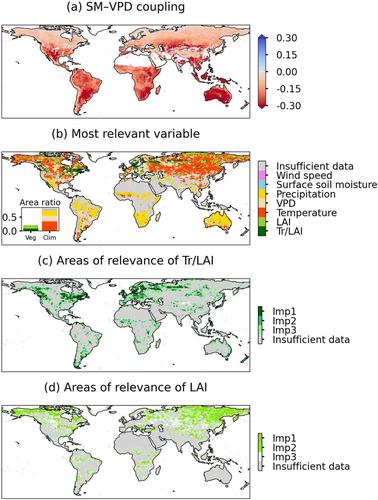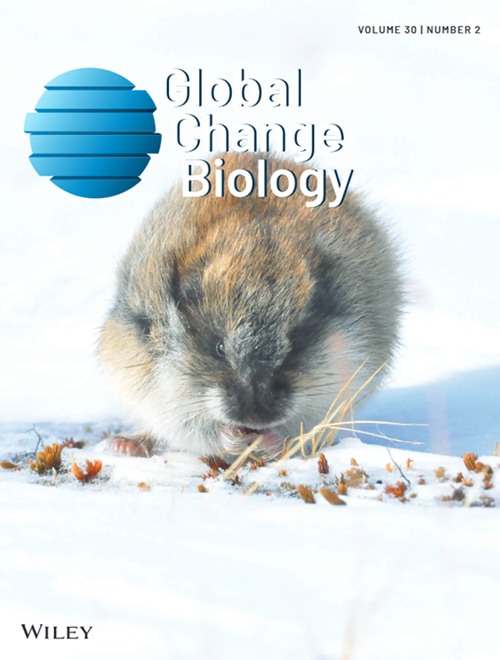植被结构和生理对陆地-大气耦合的解缠效应
IF 10.8
1区 环境科学与生态学
Q1 BIODIVERSITY CONSERVATION
引用次数: 0
摘要
陆地植被是地球系统的关键组成部分,调节着陆地和大气之间的碳、水和能量交换。植被通过吸收和蒸腾土壤水分来影响土壤水分动态,从而调节陆地-大气相互作用。此外,由于气候变化和森林管理而引起的植被结构(如叶面积指数)和生理(如气孔调节)的变化也影响陆地-大气相互作用。然而,在全球范围内,植被结构和生理在调节陆地-大气相互作用中的相对作用尚未得到很好的理解。本文研究了植被结构和生理对土壤水分(SM)和水汽压亏缺(VPD)耦合的贡献,同时考虑了有影响的水文气象变量的贡献。我们着眼于生长季SM低于正常水平的时期,明确研究土壤干燥时植被对SM - vpd耦合的调节。我们使用一种可解释的机器学习方法来量化和研究SM-VPD耦合对植被变量的敏感性。研究发现,在北半球寒温带地区,植被结构和生理对SM-VPD耦合具有很强的控制作用。植被结构和生理对SM-VPD耦合表现出相似且占优势的负敏感性,植被动态的增加导致SM-VPD负耦合增强。基于地球系统模型模拟的分析表明,模型在很大程度上再现了植被生理对SM-VPD耦合的影响,但曲解了植被结构的作用。通过这种方式,我们的研究结果指导了模型的开发,并强调了对植被结构和生理作用的更深入理解是更准确预测未来气候和生态系统的先决条件。本文章由计算机程序翻译,如有差异,请以英文原文为准。

Disentangling Effects of Vegetation Structure and Physiology on Land–Atmosphere Coupling
Terrestrial vegetation is a key component of the Earth system, regulating the exchange of carbon, water, and energy between land and atmosphere. Vegetation affects soil moisture dynamics by absorbing and transpiring soil water, thus modulating land–atmosphere interactions. Moreover, changes in vegetation structure (e.g., leaf area index) and physiology (e.g., stomatal regulation), due to climate change and forest management, also influence land–atmosphere interactions. However, the relative roles of vegetation structure and physiology in modulating land–atmosphere interactions are not well understood globally. Here, we investigate the contributions of vegetation structure and physiology to the coupling between soil moisture (SM) and vapor pressure deficit (VPD) while also considering the contributions of influential hydro-meteorological variables. We focus on periods when SM is below normal in the growing season to explicitly study the regulation of vegetation on SM–VPD coupling during soil dryness. We use an explainable machine learning approach to quantify and study the sensitivity of SM–VPD coupling to vegetation variables. We find that vegetation structure and physiology exert strong control on SM–VPD coupling in cold and temperate regions in the Northern Hemisphere. Vegetation structure and physiology show similar and predominant negative sensitivity on SM–VPD coupling, with increases of vegetation dynamics leading to stronger negative SM–VPD coupling. Our analysis based on Earth system model simulations reveals that models largely reproduce the effect of vegetation physiology on SM–VPD coupling, but they misrepresent the role of vegetation structure. This way, our results guide model development and highlight that the deeper understanding of the roles of vegetation structure and physiology serves as a prerequisite to more accurate projections of future climate and ecosystems.
求助全文
通过发布文献求助,成功后即可免费获取论文全文。
去求助
来源期刊

Global Change Biology
环境科学-环境科学
CiteScore
21.50
自引率
5.20%
发文量
497
审稿时长
3.3 months
期刊介绍:
Global Change Biology is an environmental change journal committed to shaping the future and addressing the world's most pressing challenges, including sustainability, climate change, environmental protection, food and water safety, and global health.
Dedicated to fostering a profound understanding of the impacts of global change on biological systems and offering innovative solutions, the journal publishes a diverse range of content, including primary research articles, technical advances, research reviews, reports, opinions, perspectives, commentaries, and letters. Starting with the 2024 volume, Global Change Biology will transition to an online-only format, enhancing accessibility and contributing to the evolution of scholarly communication.
 求助内容:
求助内容: 应助结果提醒方式:
应助结果提醒方式:


